- Introduction
- EDUCATION
- INNOVATION & VC
- GLOBAL LEGACY
From 1926 to 1966, Doriot taught nearly 7,000 students at HBS. "Doriot showed a singular capacity to...draw his experience into his teaching and to practice what he preached. Unlike most teachers, he had a record of acting on his ideas," author Jean-Louis Barsoux asserts.8 Doriot's students remembered the professor's distinct style: trimmed moustache, three-piece tailored suit, white handkerchief, pipe, and calm, deliberative voice delivered with a French accent. Doriot had a "studied technique of infuriating students into positive brilliance," business historian Jeffrey Cruikshank observes.9 Viewed as a highly original, theatrical, and sometimes provocative figure, the professor influenced generations of students whose impact on business was felt globally. "[P]rivate enterprise was his holy grail," recalls Walter J. Curley (HBS MBA '48). "He loved every minute, and he conveyed that....[Y]ou really learned from his passion and from his entrepreneurial fire."10
Doriot became well known for his Manufacturing course, a second year class he began teaching in 1937. The full year course resembled no other as Doriot eschewed the case method, the basic system of HBS instruction. Doriot based the class on lectures (students were asked to listen and take notes, but not ask questions) and fieldwork. Teaching this single class for nearly 30 thirty years, Doriot continually reflected upon and refined his pedagogy. His copious lecture notes, many of which resemble a flowchart, reflect the orderly, logical fashion in which he structured and conveyed his philosophy on the art and science of business.
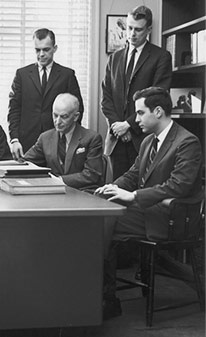
"Business to [Doriot], and he hopes to you, can be one of the most satisfying and rewarding endeavors imaginable, if the proper philosophy and pattern of actions guide it. He is attempting to give you that philosophy and pattern of action, and to help you develop your own."
George E. McCown (HBS MBA '62), Research Assistant to Georges Doriot, 196211
George E. McCown (HBS MBA '62), Doriot's teaching assistant in the early 1960s, explained that "General Doriot selected the name Manufacturing because he believes this activity is the hard core of our great industrial strength and one of the foundations of our business system....He believes that one can find great creative satisfaction in the changing of raw materials to finished goods."12 William Draper (HBS MBA '54) remembers Doriot counseled students that initially "[y]ou don't want to go into financial things...You want to go into something which is real business where they make something."13 The combined topics addressed in the class–operations of a manufacturing company; leadership and entrepreneurship; working with investors and consultants; and research and development of new products–represented, in Doriot's view, the core opportunities and challenges faced by business leaders and venture capitalists.
Doriot focused on the qualities that defined the successful business leader–one who made significant contributions to society and the economy. Gupta notes that Doriot taught students, "Businesses exist because they serve a larger purpose, not simply to make money. And those [students] who failed to remember that would, in the long run, hurt themselves and the environment they operated in."14 Enrollment in his Manufacturing course, Doriot cautioned, entailed a "particular and superior form of responsibilities as businessmen, as citizens," and he urged graduates to "carry on with dignity–modesty–tact and courage all the responsibilities that your new degree implies."15
Students were asked to carefully examine their own characters and personal codes of conduct. Doriot advised that "[c]onstant observation, perception, understanding, appreciation together with a strong desire to be constructive, to make contributions in all directions, must be part of your make up. Make use of your assets and liabilities to the maximum."16 The professor even instituted a lecture for wives of students in the Manufacturing class, in which he outlined his beliefs on the role spouses in the postwar era could play in the success of HBS graduates.
Drawing upon his own work in the military and at ARD, Doriot emphasized the value of first-hand experience in the business world. "He wanted us to hear what it's like in real business," Draper remembers.17 Through his wealth of connections, Doriot invited leaders in industry and government into the classroom to speak. "The able and fine manufacturers all over the nation...gave practical sense and meaning to my classes," he wrote, helping students "not only to reflect, but to act."18 His guest lecturers over the years included Leslie Groves, the head of the Manhattan Project; Henry Dreyfuss, industrial designer; Margaret Rudkin, founder of Pepperidge Farms; and John Deutsch, chemist and provost of MIT, and later Deputy Secretary of Defense and Director of the CIA.
For fieldwork assignments, teams of eight to ten students studied and consulted with two manufacturing companies in the Boston area. It was Doriot's conviction that "getting students out into the field was more effective than bringing the field into the classroom (in the form of cases)," Cruickshank writes, and many of the students "found themselves transformed by that experience."19 Doriot advised students in their fieldwork with manufacturing companies to "do constructive work for them?" and "develop a sense of operations"[a] feeling of participating, leading."20
Writing assignments for the Manufacturing course included a topic report focusing on subjects, chosen by students, which addressed the impact of a product or technology 10 to 20 years out. Doriot envisioned these reports as significant "contribution[s] to the future of American business."21 Covering an extraordinary range of topics over the years, from plastics to fiber optics, the reports forecasted the future of leading technologies. Many reports became influential publications. For example, "Making the Automatic Factory a Reality," written by a team led by John Diebold (HBS MBA '51), forecasted the role of computers in business and turned into a published classic. "Masers and Lasers," written by a team headed by Sir Christopher A. Hogg (HBS MBA '62) and Lawrence G. Sucsy (HBS MBA '62), was regarded as a respected analysis of the potential of laser technology. The well-known textbook Creative Collective Bargaining; Meeting Today's Challenges to Labor-Management Relations, by James A. Henderson (HBS MBA '63), likewise arose from his Manufacturing course report.
Doriot retired from HBS in 1966.22 In 1979, the Professor Emeritus was invited back to campus to give a refresher course, and throngs of colleagues and former students filled the lecture hall. Throughout his life, Doriot remained a generous teacher and mentor. "[Doriot] enjoyed working with his former students...on a one-to-one basis," explains Robert McCabe (HBS MBA '58). "He took great pleasure from watching their growing success in business and in life. His loyalty to them...knew no bounds. They were his family."23 Doriot's lessons and principles impacted generations of students, who went on to make significant contributions in venture capital firms, successful startups, and the country's top corporations. "[Doriot] motivated and heightened in me the drive always to be the best in every situation," notes Marvin S. Traub (HBS MBA '49). "That urgency to be the best and understand every situation is what I felt Manufacturing was all about."24
8
George E. McCown, "Assistant's Lecture," 9 October 1962, 5. GFD-HBS.
9
Jean-Louis Barsoux, INSEAD: From Intuition to Institution (New York: St. Martin's Press, 2000), 9.
10
Cruikshank, A Delicate Experiment: The Harvard Business School 1908-1945 (Boston: Harvard Business School Press, 1987), 171.
11
Walter J. P. Curley, interview by Carole Kolker in National Venture Capital Association Venture Capital Oral History Project: Venture Capital Greats, 24 March 2010. Arlington, Virginia: National Venture Capital Association, 2009, 28-29.
12
McCown, 4-5.
13
William Draper, III, Harvard Business School Entrepreneurs video archive transcript, December 2010, 2, accessed October 3, 2014. http://www.hbs.edu/entrepreneurs/pdf/bill.draper.pdf.
14
Gupta, ed., First Venture Capitalist, 3.
15
Doriot, "Closing Statements by General Georges F. Doriot to Manufacturing Class - 17 May 1966." GFD-HBS.
16
Doriot, "Manage, Lead, Command, May 1965." Georges F. Doriot: Manufacturing Class Notes, Harvard Business School 1917-1966 (Boston: Board of Trustees, The French Library of Boston, 1993), 137.
17
William Draper, III, interview by Sally Smith Hughes, in "Early Bay Area Venture Capitalists: Shaping the Economic and Business Landscape," Venture Capitalists Oral History Project, The Bancroft Library Regional Oral History Office (The Regents of the University of California, 2009), 9.
18
Doriot, "Outline of Remarks (Excerpts), HBS Club of New York Business Statesman Award, 3 May 1966," 1. GFD-HBS.
19
Cruikshank, Shaping the Waves: A History of Entrepreneurship at Harvard Business School (Boston: Harvard Business School Publications, 2005), 349-350.
20
Doriot, "Orientation Class for First-Year Students 5 May 1961," 2. GFD-HBS.
21
"General Doriot's Topic Reports," HBS Bulletin, June 1963: 12.
22
Upon Doriot's retirement in 1966, friends and associates established a fellowship in Doriot's name that offered financial support for students from abroad to attend HBS.
23
Robert McCabe, "Foreword" in Gupta, ed., First Venture Capitalist, x.
24
Marvin S. Traub quoted in Ante, 133.

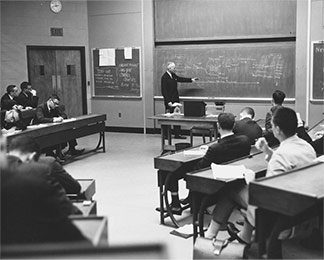
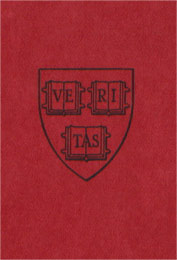
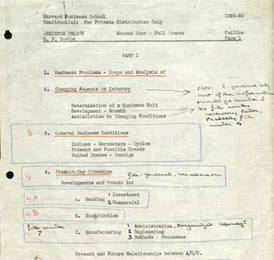
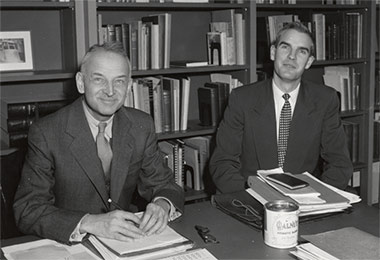
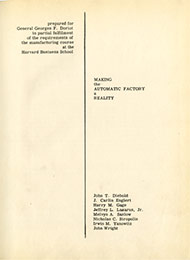
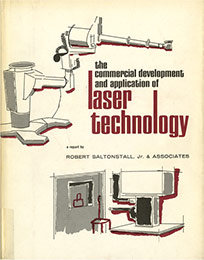
![John Diebold. Automation: The Advent of the Automatic Factory. New York, Van Nostrand [1952].](../../img/thumbs/323A-t.jpg)